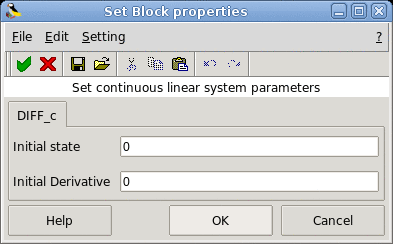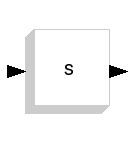Derivative block (implicit)
The implicit Derivative block provides the derivative of its input. This block imposes the algebraic constraint (x=u) on the solver, where u is the block input and x is the internal state. The solver varies the internal states to make state x follow the input's variations. The solver computes the derivatives of the state which is made available at the block output. The solver uses multi-order multi-step BDF (backward differentiation formula ) method to estimate the derivative. The accuracy of this method is higher than "du/dt" block which uses order 1 method. In order to increase the accuracy of the derivative, the user can reduce the error tolerances.

- Initial state
Initial value of the state used as initial guess to help the solver to converge toward the solution. This is specially useful at the beginning of the simulation.
Properties : Type 'vec' of size -1.
- Initial Derivative
Initial value of the state derivatives used as initial guess to help the solver. The very first output of the block is the initial derivative vector.
Properties : Type 'vec' of size -1.
- always active: yes
- direct-feedthrough: no
- zero-crossing: no
- mode: no
- regular inputs:
- port 1 : size [1,1] / type 1
- regular outputs:
- port 1 : size [1,1] / type 1
- number/sizes of activation inputs: 0
- number/sizes of activation outputs: 0
- continuous-time state: yes
- discrete-time state: no
- object discrete-time state: no
- name of computational function: diffblk_c
- SCI/routines/scicos/diffblk_c.c (Type 10004) [view code]
Masoud Najafi INRIA


